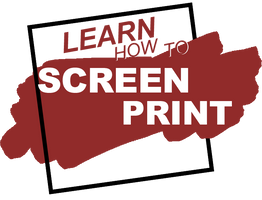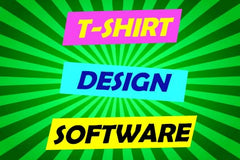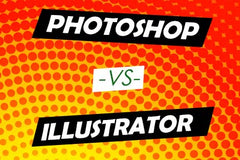There is more than one way to decorate garments. You can tie-dye, embroider, heat press, screen print, dye sublimate, and applique garments. This is really just a small list of the options for decorating garments. The concept of decorating garments has been around for centuries. This is a screen printing blog. Our sole purpose is to explain how to screen print. It’s even in our name.
We started another website called Learn How to DTG Print so that we could discuss DTG printing in just the same way that we discuss traditional screen printing. The reason we did this is because direct to garment printing rivals screen printing. It is important for people to understand the differences between each of the concepts. That is what this post is about.
What is screen printing?
Screen Printing is a process of applying a design to a shirt with ink using a screen. The ink is typically made of plastisol, but it can also be water-based ink as well.
The process involves 7 major steps: Create a Design, Prepare a Screen, Exposing a Screen, Wash Off The Emulsion, Prepare the Item to Be Printed, Applying the Ink, Dry the Garment. Each step has quite a few intricate parts. Someone new to screen printing will need to master each of these steps. This happens over time as each new screen print teaches them something new.
Screen printing is good for printing hundreds or thousands of shirts, but it is labor intensive.
What is direct to garment printing?
Imagine just being able to print a design on a shirt with a printer. You just have to push a button. That’s exactly what a direct to garment print is. DTG printing is a newer technology and growing rapidly in popularity.
Special printers that are similar to inkjet printers apply the ink to the shirt. The process of DTG printing involves creating a design, uploading it to the printer, pretreating, printing the shirt, then drying the shirt.
After the printer has printed the design onto the shirt the ink must cure. This is similar to regular screen printing. This means that if you are printing with a DTG printer you will need a heat press or conveyor dryer to cure the ink.
The concept of direct to garment printing is so exciting that companies such as Amazon have gotten into the game. If you only have to push a button then anybody can do it. Which means that a lot of companies want to get into DTG printing. What they have discovered is that it’s a lot more difficult than what they originally thought. Amazon has had a lot of problems with their DTG business.
There are a lot of things to consider when operating a DTG business.
The Benefits of DTG Printing
It doesn’t take a long time to print a lot of shirts with traditional screen printing. However, it takes a lot of set up time to print that many shirts. For a typical 4 color shirt you must use 5 screens. The amount of time it would take to create the 5 screens would be significant and it would cost money. Once you had the screens ready then you could print quite a few shirts, but remember it is labor intensive. To print a lot of shirts quickly you will need labor to create them. All of this works if you have hundreds of shirts that need to be printed. If you had a small order then it could potentially take more time to set up the order than it would to print the order.
With a DTG printer this problem is alleviated. DTG printing does not have a lot of setup costs or time issues involved. You can print a small quantity of shirts quickly. An order of 10 - 20 can be completed relatively quickly.
Drawbacks of DTG Printing
DTG is a new technology. So it is not completely standardized yet, but it has come a long way. With all technology it gets better as it goes along. The printers are improving. With each iteration there is some improvement to the technology.
Nonetheless, there are many reasons that DTG printing has drawbacks.
The Cost of DTG Printing is Expensive
The equipment for DTG printing is expensive. The printer alone can start at $15,000. For the average person that is significant. Not only do you need the printer, but you potentially need a pretreat machine as well as a flash dryer.
The ink is expensive as well. To print one shirt with pretreatment and ink alone can exceed $4.
While it seems quite simple, there is labor involved. That costs money as well unless you are going to do it yourself. It is not as simple as pushing a button. You need a staff that understands the complexities of printing with a DTG printer. Plus, with the equipment being so expensive you need to constantly maintain it. You must protect your investment. You will have to maintain it every single day.
Lack of Speed is a Concern
Traditional screen printers are much faster than DTG printers. As stated previously a DTG printer works very similarly to an inkjet printer. It is a line printer. It prints lines of color over and over.
The amount of prints that you can print in an hour is lower. It stretches anywhere between 20 and 30 shirts. When you compare 20 - 30 shirts/hour to traditional screen printings potential to print 1000 shirts/hour you can see there is a stark difference.
At the end of the day traditional screen printing is simply faster.
Durability is Low
The prints that a DTG printer make are not as durable as with traditional screen prints.
DTG prints fade quickly. This is due to washing and drying the garments repeatedly. It is caused by the ink and the way that the ink is applied. Would you want to pay for a shirt that could fade quickly?
This does not mean that DTG prints aren’t good. You can still get a lot of washes out of a DTG print. A DTG print can get around 50 washes. That is usually enough for a DTG customer.
DTG customers have different needs from screen print customers. They need fewer shirts. They have a lot more colors. They are more of a specialty print. If you were printing the shirts for an entire company then you wouldn’t want to print with a DTG printer because the shirts just wouldn’t last. A company that uses these shirts as a uniform would not get their money's worth. They should expect to replace them every year.
Pretreating Issues
If you are going to print on a dark shirt or you want vibrant colors, or print with white ink then you must pretreat the shirt. It takes additional time to pretreat a shirt. It costs more to pretreat a shirt.
To apply pretreatment you will need to use a roller or use a pretreat machine. Remember that these are extra costs as well. The solution used to pretreat costs money. The equipment costs money. The labor costs money. All of these factors weigh on DTG printers.
Pre-treatment will degrade if applied in advance. This means that the ink will not adhere to the garment. You must apply it immediately before printing the shirts.
There are Reasons that DTG Printers are in Print Shops
Many screen printers add DTG printers to their mix so that they can take on smaller orders. They don’t want to turn customers away so they add the DTG printers to their offerings. With a DTG printer the screen printers can take on a small order. It’s a win-win for everybody.
The Artwork is not Great with Traditional Screen Printers
In some instances the artwork does not work for traditional screen printers or very intricate details. Particularly if the artwork has many colors. That would be very difficult for a normal screen printer who typically only prints with 4 colors. A DTG printer can print a color photograph. A photograph can have higher resolution. It can show gradients. Traditional screen printing cannot show gradients.
DTG Printers Can Accommodate Small Orders
Screen printing is optimal for large audiences. That being the case, it is not profitable for small orders. If a traditional screen printer didn’t have a DTG printer then they would not be able to take these orders. A screen printer will have to turn them away. This will potentially anger the customer. It's not uncommon for a customer to come in and order only 3 shirts. They are simply turned away. The order is just too small.
With the cost of the equipment being so expensive a screen printer may want to consider outsourcing any DTG orders before purchasing a DTG printer. In fact, depending on the finances of the shop, they may be forced to outsource. Perhaps striking a deal with a smaller printer is the better solution.
Rush Orders Are Easy With DTG Printing
People who DTG print can easily accommodate a rush order. It’s typically a smaller order and does not require as much labor. Once the printer is ready, you just pretreat the shirts and print them out. Using a flash dryer you can dry them in a snap. This means that the prints can be ready to go quickly. You will be able to quickly meet their needs.
Replacements Happen Fast
Accidents happen. Sometimes an order is missing a shirt. You can easily print out a replacement using a DTG printer. This would be much easier and faster than creating a new screen to print out a new shirt. This would also be true if a printed shirt didn’t turn out correctly.
Sometimes return customers come in and don’t need as many shirts as they did in a previous run. This is a perfect opportunity to use the DTG printer. First of all, you would possibly have to charge them a new setup fee if you didn’t still have their screen. You could keep those customers happy by just popping the new shirts into the DTG printer.
The major difference between DTG and Screen Printing is volume of printing. DTG is the best way to print a few shirts. Screen printing is the best way to print hundreds of shirts.
Which is better? Direct to Garment printing or Screen Printing?
You must first consider the order that a customer is placing. There are a few small factors that determine whether you will be able to use screen printing or DTG to fulfill the need. Typically those factors come down to order size, artwork, and the shop’s abilities.
First Check the Artwork
You need to review the artwork. You need to determine if the artwork can be separated easily. If you can print this image using up to 4 colors then it is prime for screen printing. If the image has many colors or a gradient then you are better off using a DTG printer.
DTG printers are meant for photographs. If you want to print a photo, you should use a DTG printer. That is, unless you are printing a lot of copies. Then financially you would need to switch to a screen printer.
Subcontracting DTG Prints
Only you can determine what is best for your shop. You may determine that a shop simply cannot accommodate a customer's request. You can still please the customer by subcontracting the work to another printer who can accommodate it. If you choose to just offer traditional screen printing then you can contact a subcontractor and work out a deal.
Pretreating DTG shirts
Practically every shirt will need to be pretreated when you are DTG printing. You must pretreat shirts that need vibrant colors printed on them, are dark in color, or have white ink in the design.
The reason for this is because the pretreatment allows the print to adhere to the garment. It is an under-base for the print. Without the pretreatment the print may not adhere to the garment. It may also fade much quicker than intended. Bright colors will appear dull. This would not be good.
Pretreatment is a step in the process of DTG Printing. You can either apply the pretreatment solution with a roller or with a pretreatment machine. A pretreatment machine will cost anywhere from $2000 to $5000.
Then you also have the ongoing cost of the solution. This is in addition to the ink that you may be using on the shirt itself. Plus it takes additional time to do the pretreatment. All of this costs money.
Pricing DTG Prints
It is possible to calculate all of the costs on a DTG printed shirt. You can calculate the ink, pretreatment, and cost of a blank shirt. Pricing comes down to a few simple costs: Labor, Ink, Pre-Treat, Garment. Add all four of those costs together and you will come up with your total cost to print a DTG shirt. It really is that simple.
DTG Printer Costs
Purchasing a DTG printer can get expensive. DTG printers can start at $15,000 and go up from there. Some of the models sell for $250,000. So it is expensive. The real question is, “is it worth it?”
You must understand that a DTG printer is not going to add anything to your business. You are not going to suddenly have an influx of customers that just want a DTG print. What it will do is stop potential customers from going out of your shop to another shop to print their shirts. If you are a screen printer and you are consistently sending customers to other stores because you just cannot accommodate them then making the capital investment into a DTG printer makes sense.
Pre-Treat Machines and Heat Presses
If you want to add DTG printing to your repertoire then you will have to purchase the printer along with a pretreat machine, and a heat press.
Heat Press Machines
A heat press is a machine that imprints a graphic design onto a garment using heat applied with metal plates. There are two main types of heat press machine. They are clamshell and swing away. Each of them comes with their own pros and cons that we will cover in another blog.
Clamshell Heat Presses
A clamshell heat press is usually a tabletop machine that has two large plates separated by a hinge. The opening and closing of this type of heat press resemble that of a clam. A clamshell heat press is the most commonly used heat press on the market. These heat presses cost anywhere from $300 - $500.
Swing Away Heat Presses
A swing away heat press is one where the bottom plate remains stationary and the top plate swings away so that you have complete access to the bottom plate when you are changing the substrate that you are working with. These heat presses usually come with a stand for easy movement. They are more expensive than clamshell heat presses and they will run you anywhere from $1000 - $1500.
Pretreat Machines
A pretreat machine simply sprays a solution onto a shirt. Sometimes they are called pretreat sprayers. There are manual pretreat machines and automatic pretreat machines. These machines will cost anywhere from $2000 and $5000. This is one of the most important pieces of equipment a shop can have.
DTG Printing Ink Costs
There is a significant price difference between screen printing ink, and DTG ink. Clearly DTG ink costs much more.
DTG inks are brand specific. Each DTG Printer will only take its own kind of ink.
A cartridge of DTG ink can cost around $200. Each DTG printer has 6 cartridges. There is one cartridge for each of the CMYK colors and two white inks. That's $1200 worth of ink in every printer. The ink is not cheap.
Also, know that the ink has a shelf life. This is a major difference from plastisol ink. You must use the ink before it expires. You do not have to use plastisol ink right away.
Which Feels Better?
DTG prints are softer than screen prints. The plastisol is thick and heavy. Ultimately, the plastisol is more durable. When you compare which feels better it ultimately is a toss up. The consumer may prefer one over the other. They make that decision.
The Final Word on Screen Printing Compared to DTG Printing
There are people who swear by screen printing over DTG printing. There are those who don't like screen printings limitations. When making the decision which is better you must evaluate your own needs and your customers needs. Startup price, production, ink costs, and durability are all factors in the decision.
Neither screen printing nor DTG printing meet all of the needs of the consumer. For this, all of the factors must be considered on a case by case basis. There is no clear winner.




Leave a comment